What is an Ultra Short Throw projector and why would you want one?
An Ultra Short Throw or UST projector requires very little space between it and the projection surface to project a large format image. This is achieved through ultra-wide lenses and the arrangement of the light source and lens which can be quite difficult to achieve. Generally a projector must have a throw ratio of less than 0.4:1 to qualify as a UST.
This type of setup is desirable for a number of reasons. First, there’s the question of space. With a traditional projector, you need a large enough room to get a decently sized image. You can use this nifty calculator to get a rough idea. Most traditional projectors tend to have a 2:1 throw ratio – you need to place the projector about 5 meters from a surface to get a 100-inch image. With its 0.23:1 ratio, the Formovie THEATER can achieve an 80-inch image when placed just 14 centimeters away from the projection surface, and a 150-inch image at 49 centimeters.

This allows you to have the projector facing you and therefore make the best use of any built-in speaker systems it may have, while keeping the noise from its cooling system as far away as possible.
Also, a UST projector is generally meant to be projected from a surface, such as a table or media cabinet, whereas you typically want to mount a standard projector on the ceiling to get the best picture with the least amount of keystone correction. This means that installation is normally much easier.
Introduction to the THEATER of the film
Formovie may not be a household name in Western markets, but the brand is actually well established and has a good pedigree. Formovie is a joint venture between Xiaomi, which most of you are probably familiar with, and APPOTRONICS, a world-leading company in laser display technology with its own patents and R&D and over 90% market share in the laser display space. laser cinema. So we’re really talking about some big players here.

The Formovie THEATER projector we’re reviewing today is an exciting consumer-grade high-end unit. Its formal claim to fame is being the first and only one in the world Dolby Vision and Atmos UST projector. But there’s a lot to like beyond that – 4K native resolution e 2,800 lumi ANSI of brightness. Offers ALDP (Advanced Laser Phosphor Display) 4.0 RGB+ triple laser technology – one of the most advanced current fluorescent laser technologies and a great color accuracy of 107% REC.2020 with broad HDR standard support.
FENGMI R1 Nano specifications at a glance:
- dimensjonijiet: 550 x 349.2 x 107.5mm, 9.8kg.
- Parametri ottiċi: DLP projector ALDP 4.0 RGB+ triple laser (Advanced Laser Phosphor Display) UST (ultra short throw); 4K (UHD) optical resolution (Pixel Shifting); 3000:1 contrast ratio.
- Parametri tal-projezzjoni: 2800 ANSI lumens (advertised); 20,000 hours of light source life (advertised); 80~150 inch screen diagonal; throw ratio 0.23:1; 0.47″ DMD display chip; 107% Rec.2020 color space; 60Hz.
- Aġġustament ottiku: Electric focus automatic software; Omni-directional manual keystone correction (8-point keystone correction) or 4-point keystone correction.
- Awdjo: Two 15W full-range Hi-Fi speakers and two 15W tweeters from Bowers and Wilkins; Audio output via 3.5mm jack (stereo) and multi-channel ARC over HDMI and optical S/PDIF; Dolby Audio, Dolby Audio, DTS/X and DTS-HD audio decoding.
- Intern: MediaTek MT9629 (4xCortex-A55 @ 1.5GHz); Mali-G52 2EE MC1 GPU; 2GB of RAM; 32GB memory.
- Hardware video decoder: Up to 4K video with 10-bit color depth support; AV1, AVS2, HEVC, VP9, H.264, SHVC 4K60@10bit; HDR (Dolby Vision, HDR10, HDR10+ and HLG decoding); Widevine L1 (HD streaming and higher);
- I: Internal power supply with AC 110-240V support; 2 USB 2.0 type A; 3xHDMI 2.1 (full size with eARC support on 1 port); 1 x 3.5mm stereo audio out jack; S/PDIF optical multi-channel audio output; 1 RG45 LAN port; Configuring the far-field microphone for voice assistant.
- Konnettività Wireless: dual band Wi-Fi 6; Bluetooth 5.0.
- softwer: Android TV 11 with Google services; Built-in Chromecast support and Google voice assistant.
- Karatteristiċi oħra: Far-field voice control; Remote control in box; Support for wireless projection (Chromecast); MEMC; Elimination of speckles; Auto low latency mode for gaming.
The Formovie THEATER also features an impressive 15W quad speaker system with audio optimized by Bower & Wilkins. Last, but not least, it works Android TV 11 fuq MediaTek MT9629 chipset with 2GB of RAM and 32GB of storage. The Formovie THEATER is also packed with I/O with far-field microphones for built-in Google Assistant. Also, three HDMI 2.1 doors, two USB 2.0 those, a LAN RG45 brings, 3.5mm audio jack and S/PDIF optical out.
Ispakkjar
The Formovie THEATER arrived in a huge cardboard box, which contained a slightly smaller but still massive product box inside. The inner box is made from thick cardboard and has lots of precision cut compression foam inside which is great for protecting the drive in transit. It also features a carry handle on the outside, making it perfect for transporting the Formovie THEATRE. We don’t necessarily suggest lugging around the massive projector too often, but if you plan on definitely keep the box around.
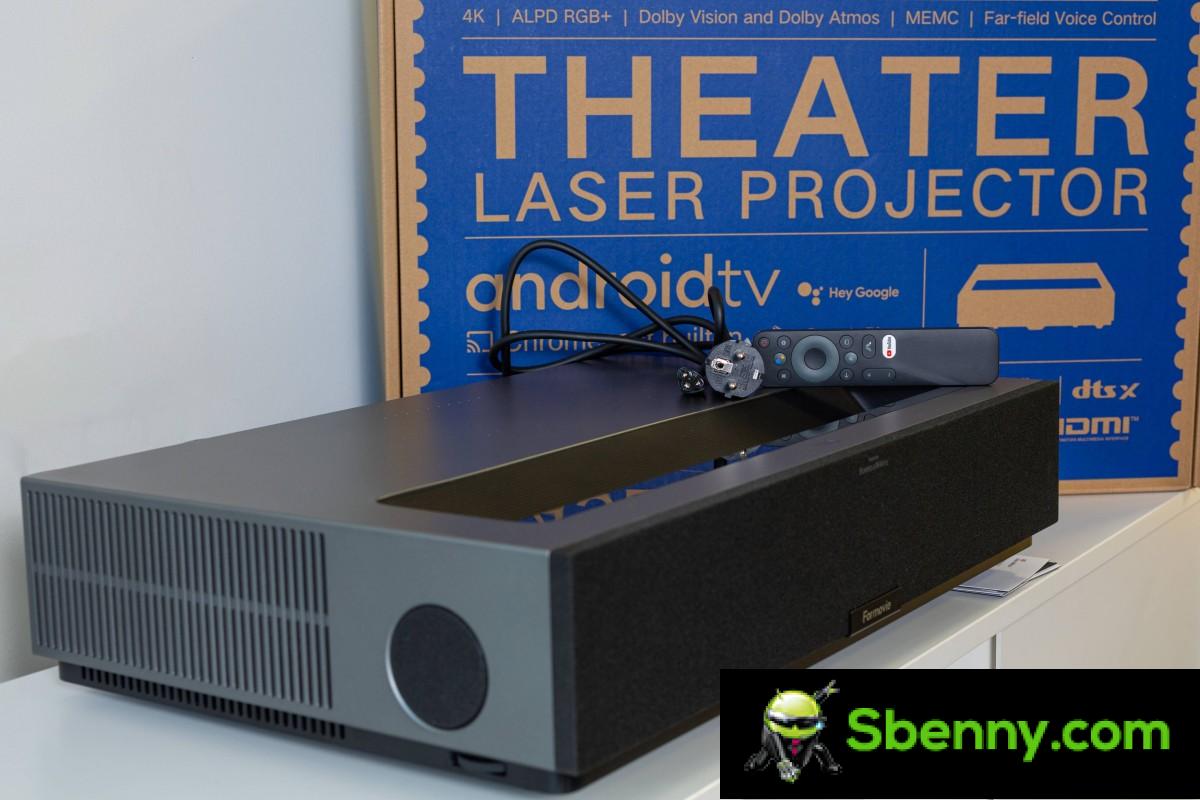
The contents include the projector itself and the proprietary remote control. The latter doesn’t even come with batteries, which is weird but not a big deal. Also in the box: A standard three-prong AC power cord like you’d find on a two-piece laptop charger. It connects directly to the rear of the Formovie THEATER as its power converter is integrated. This means less cable clutter, which we always appreciate. The only other thing in the box is a user manual and other documentation.
Hardware, ports and remote
Biex tkejjel 550 349.2 × × 107.5mm and tilting the balance a 9.8kg, the Formovie THEATER is formidable. The projector itself feels very reassuringly thick and stays firmly in place. It won’t just slide around if you accidentally bump it or the table you placed it on.
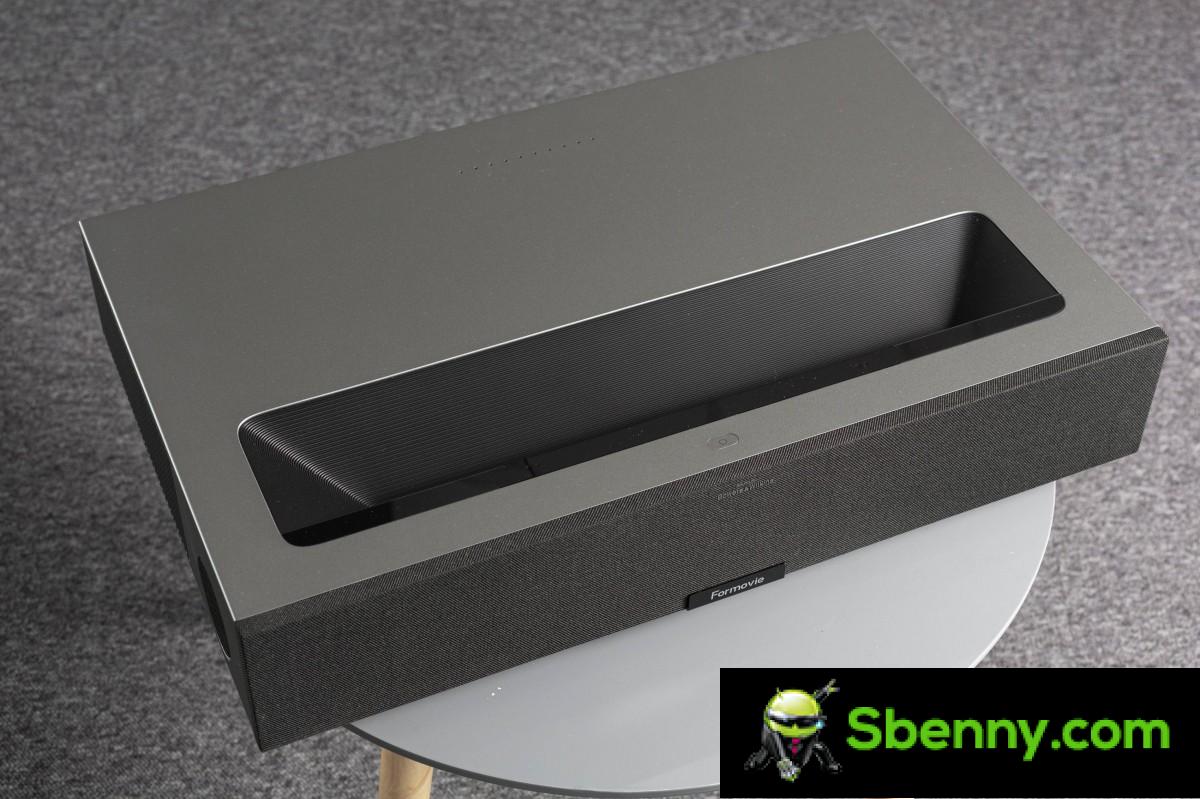
We were happy to find that the Formovie THEATER has height adjustable feet at the bottom. This means you don’t have to rely on keystone corrections alone. It is always best to physically level and position a projector in the best possible way before applying any other image corrections as these tend to detract from quality and often lead to compromises.
In terms of looks, we would probably describe the Formovie THEATER as a classic industrial design. It doesn’t feel overly modern nor deliberately retro, and should fit right in with any media closet.
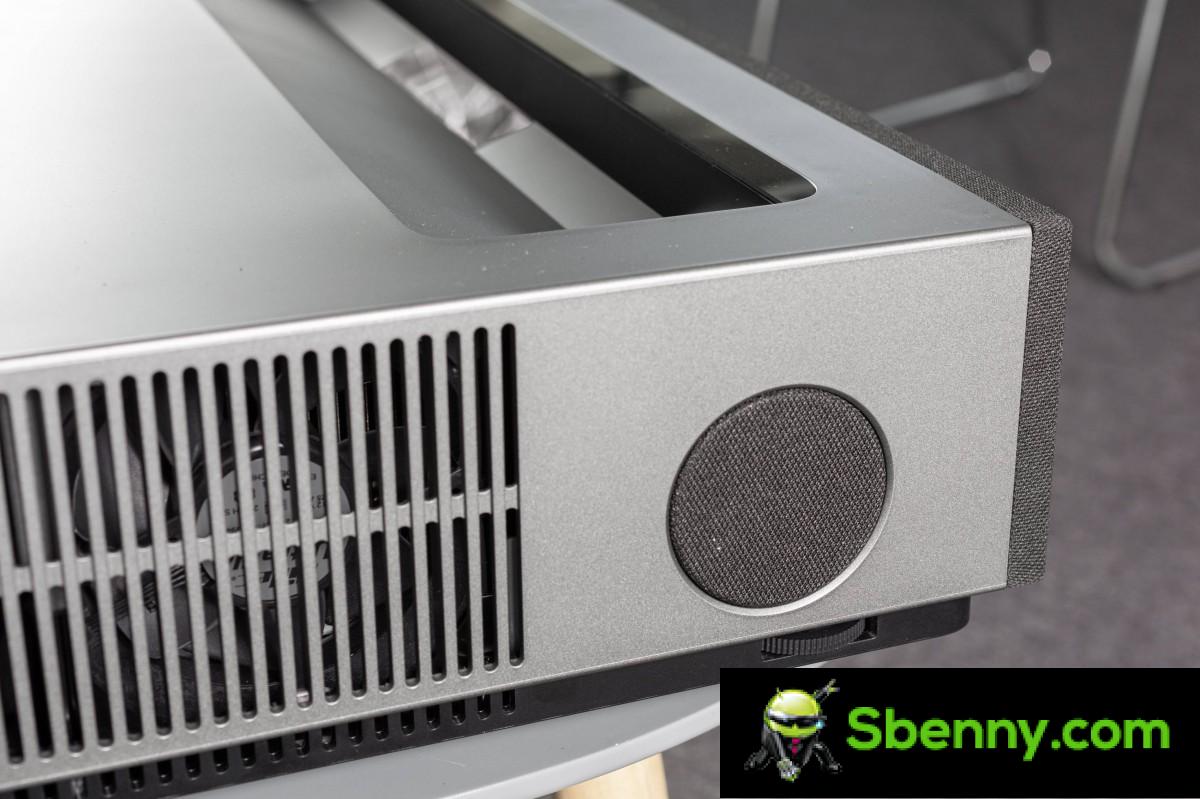
Most of the unit is made of metal with a nice matte finish that is not prone to stains or scratches. The uniform shell is interrupted by grilles on both sides of the unit. There is at least one fan inside the Formovie THEATRE. Fan noise is very low and virtually inaudible even with extended use. Being an ultra short throw projector, Formovie THEATER is meant to stay away from you. Any fan noise is easily drowned out by the excellent audio setup.
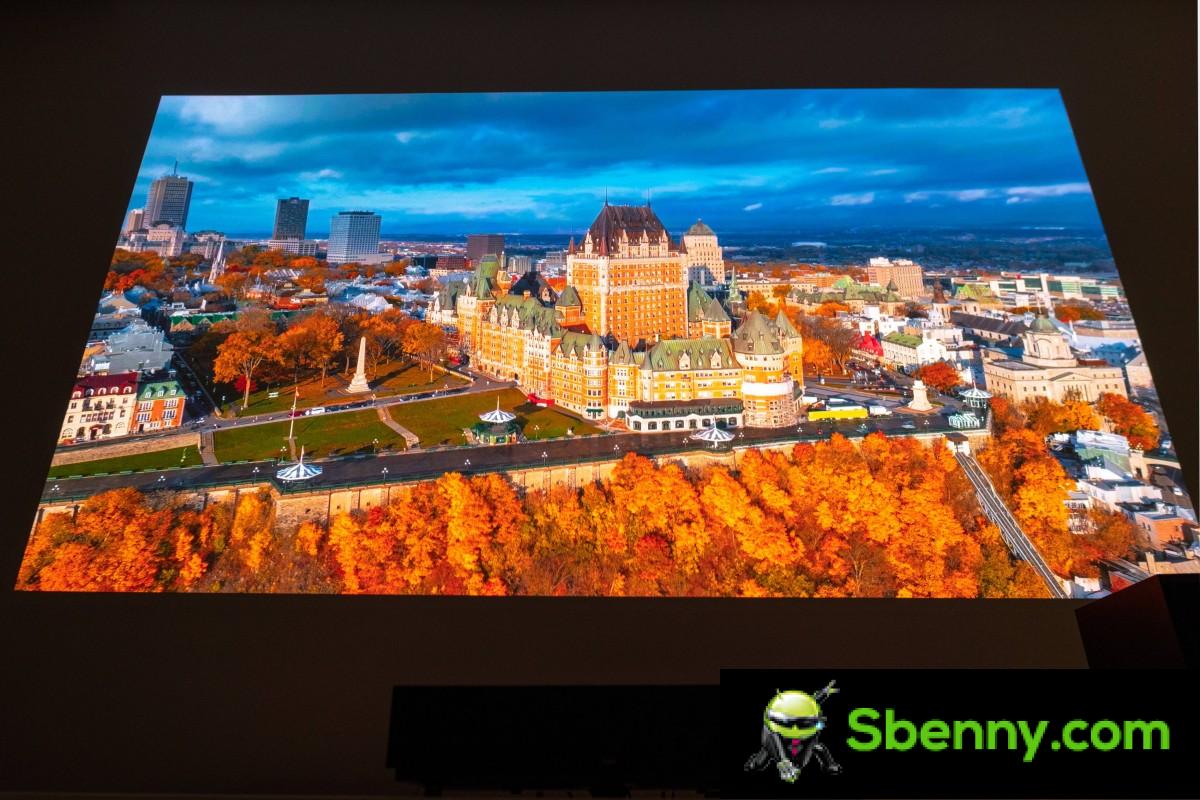
The Formovie THEATER has a total of four speakers: two full-range and two tweeters. We believe all four are placed on the front of the unit, behind the soft fabric mesh. However, some of the sound may also be directed sideways into the two circular holes on either side of the projector. These are also covered with mesh.
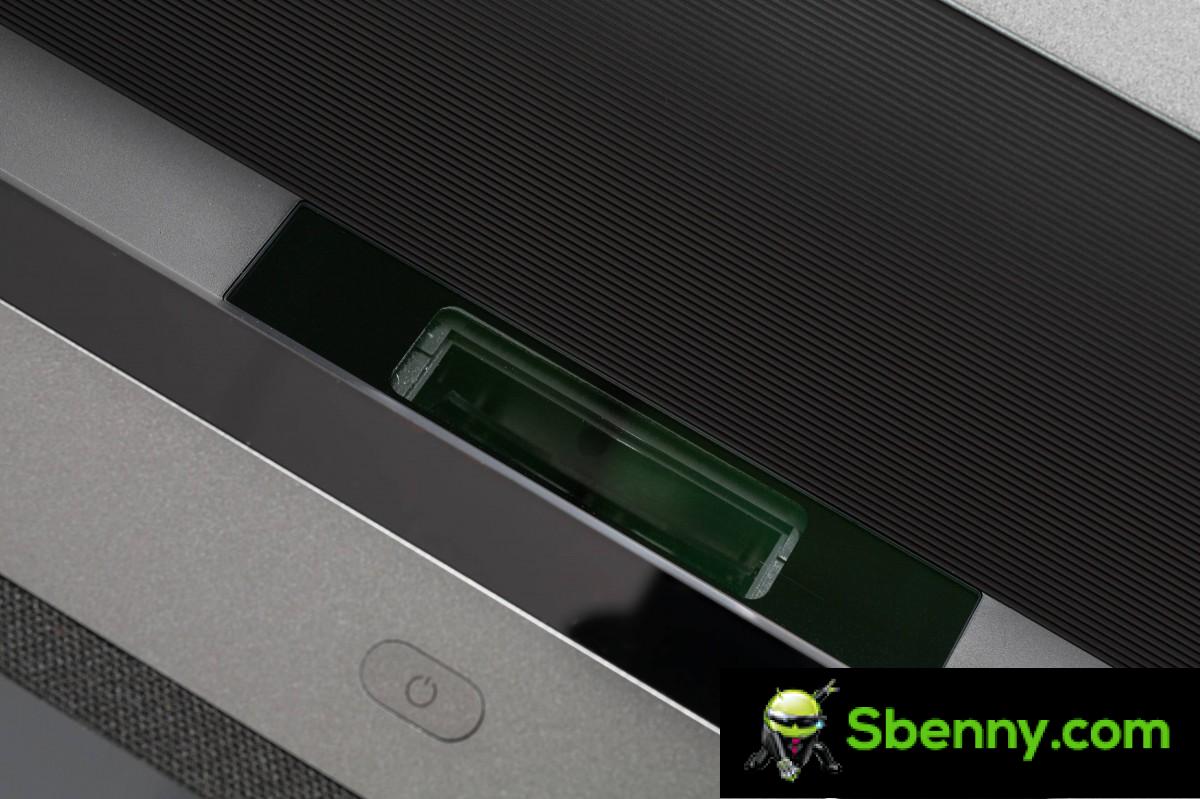
The Formovie THEATER sounds really good in person. There’s plenty of bass available, and the soundstage is rich and full. The directionality of Dolby Atmos content is also not bad at all and quite convincing.
The top of the unit looks very smooth, with just a single large slot for the business end of the optics and projection, and a couple of sensors. Unfortunately, there is no protection against dust and other contaminants. We would have appreciated a flap of some sort to keep the up-facing optics clean when not in use. The unit’s power button is also located on top.
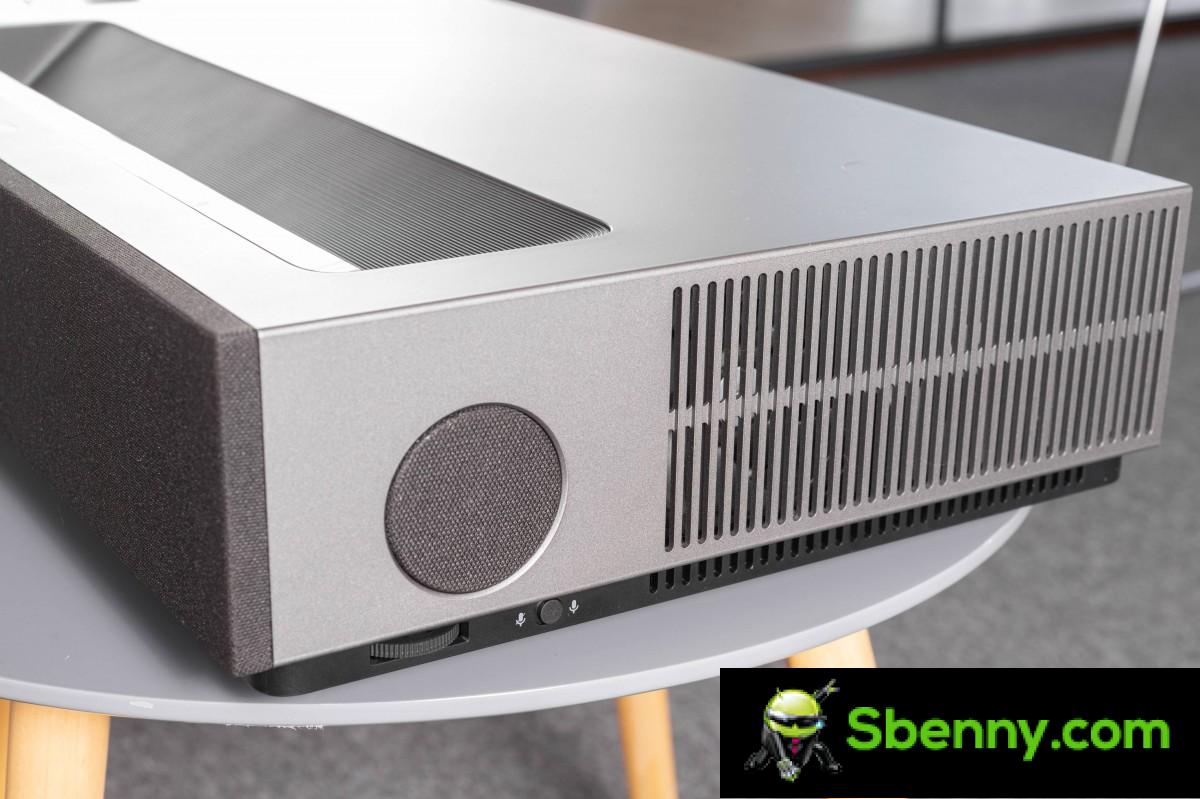
All of the Formovie THEATER’s ports are located on the back, which is great for cable management if not ultimate convenience. A front USB port would have been appreciated. With three full HDMI ports, you can successfully use the Formovie THEATER as the central hub of your multimedia setup, albeit with some limitations. Only one of the ports supports eARC (HDMI 3), which is fine by our books. We worked fine with a Samsung home theater setup for multi-channel audio output.
However, the Formovie THEATER lacks CEC, which meant we still had to control the volume of our surround sound with its remote – an annoying omission. We were also a bit puzzled as to why the HDMI ports were version 2.1. Not that we’re complaining about getting recent tech standards, but the fact is that being limited to 4K at 60Hz, the Formovie THEATER can’t benefit from the extra bandwidth of the HDMI 2.1 standard.
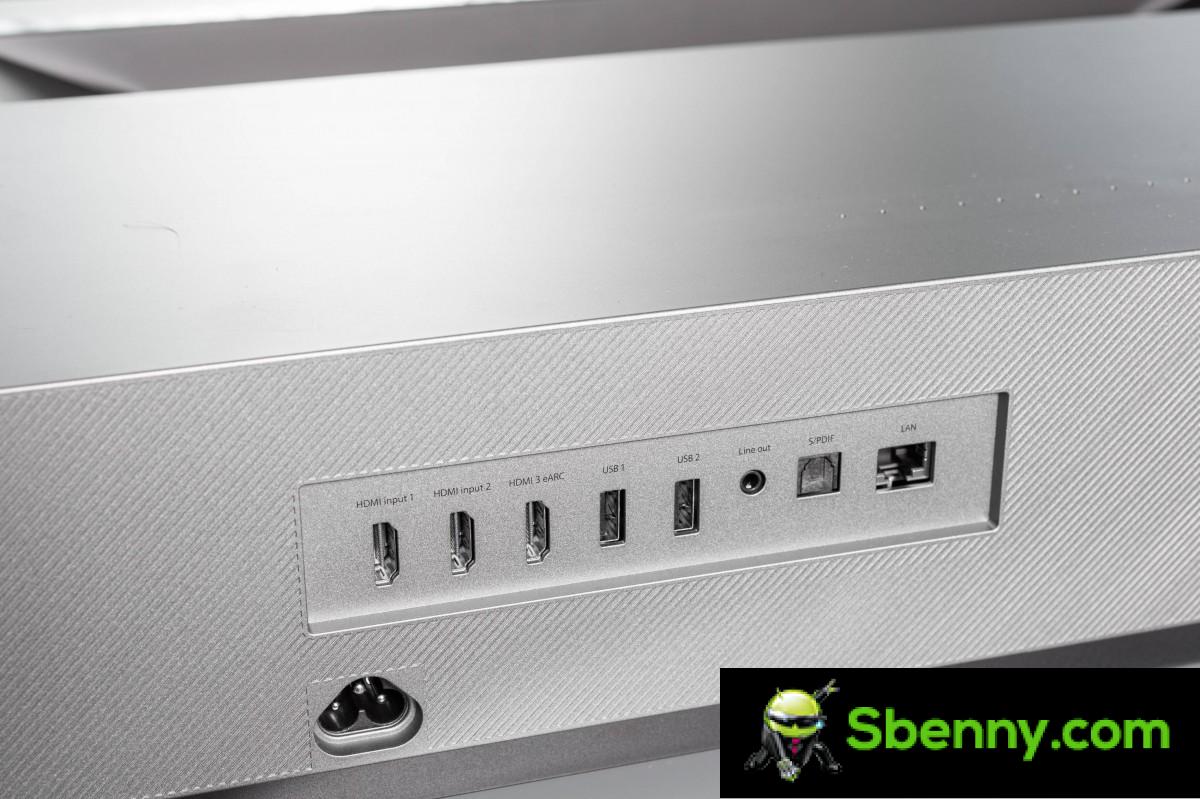
The two USB-A ports available on the Formovie THEATER are both USB 2.0 which means a theoretical speed limit of 480Mbps. Seeing as you are more likely to plug an external hard drive or SSD into said ports and consume multimedia content, the USB speeds 2.0 are perfectly adequate, even for modern 4K content.
Both the LAN port and the optical S/PDIF audio out are nice to look at and offer more flexibility in the case of the latter and better stability for the former. The 3.5mm audio jack is also welcome, although it would definitely be our last choice for audio output from the Formovie THEATRE.

The remote control for Formovie THEATER is quite basic, but works great for navigating the Android TV OS. You get a YouTube shortcut, which is handy, and a button to activate Google’s voice assistant. It’s important to note that no microphone is built into the remote. Instead, your voice will be picked up by far-field microphones on the projector itself.
Why is ALPD the next big thing?
Let’s break down some basics for anyone unfamiliar with today’s popular projector technology. In very simple terms, there are a couple of main ways to generate the light needed to project an image. The simplest fix from the past is to use a light bulb of some sort. The most common technology around is based on metal halide and UHP (Ultra High Performance) lamps, a technology that dates back to the 1960s. These types of projectors often require maintenance on things like filters and the lamp has an average life expectancy of around 3,000 hours. An alternative to these lamps is to use an LED light source, which lasts much longer – about 20,000 hours. And then there’s the best light source option currently available: a laser.
Most projectors out there tend to be marketed as DLP, LED, LCD or laser, such as the Formovie THEATER. With a few exceptions, most projectors simply labeled DLP are lamp-based, require filters, and have a burn time of around 2,000 to 3,000 hours. DLP itself stands for Digital Light Processing, a chip that uses tiny, microscopic mirrors and a spinning color wheel to create an image. DLP chips are also used in other types of projectors, especially laser ones.

A projector marketed as LED is typically a DLP projector that replaces the lamp with an LED light source that is expected to last around 20,000 hours, use much less energy, and have virtually zero maintenance. It’s, on average, dimmer than an LCD or DLP projector, but it’s also much smaller, allowing for things like pico projectors.
On the other hand, LCD projectors tend to require constant filter maintenance. They don’t have a DLP chip, so fewer or no moving parts. On average, they’re more affordable due to their simpler one-chip implementation, though usually at the expense of image contrast. You can get three-chip LCD projectors that fix some of these problems, but they’re also more expensive as something in between. LCD units tend to offer a very sharp image but with lower than average contrast.
The Formovie THEATER is a ALDP extension proġettazzjoni, li tirrappreżenta Wirja avvanzata tal-fosfru bil-lejżer, which is probably the most advanced fluorescent laser technology. Laser projection has basically all the advantages of LED projection: the light source is compact and energy efficient and allows for easier non-standard optical angles, which is exactly what the Formovie THEATER’s ultra short throw optics are.
You also get the benefits of virtually no maintenance and approximately 20,000 hours of life expectancy for the light source. One of the main advantages of laser projection over LED is the availability of a significantly brighter light output (theoretically up to 30,000 lumens).
ALPD has gone through some interesting iterations over the years and the Formovie THEATER uses the latest version (that we know of) of the technology. All versions share the basic principle of having a laser as the primary light source, usually a blue laser, which then shines on a rotating wheel coated with yellow phosphor, exciting yellow light which produces phosphor.
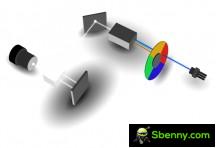
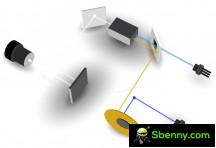
ALPD technology: V1 • V2
In its simplest version, the yellow light is then separated using dichroic coatings to create red and green light, while the blue light component passes directly through a scattering segment in the phosphor wheel. The separated red, green and blue colors are then sent to an imaging surface such as a DLP chip, which in turn sends light through a lens and onto the projection surface.
Laser projectors generally come in single laser or triple laser varieties such as the ALPD 4.0 Formovie THEATER. In a single laser projector, all primary colors must be derived by separating them from a single laser beam with a color wheel. This has some drawbacks, such as blue tint and occasionally a rainbow effect of colors on fast moving images. Also, the color wheel itself often tends to produce a high-pitched whine. These are all issues that a three laser ALPD 4.0 projector does not have since it has all primary colors as direct laser light sources. This technology also offers the benefit of richer, deeper colors and wider color-space coverage.
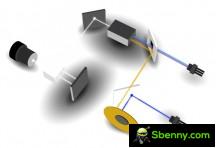

ALPD technology: V3 • V4
Projection performance, features and settings
The Formovie THEATER definitely lives up to the ultra short throw classification. The first impression can be quite surprising if you’ve never tried one before. If you push the projector up against a wall or other surface, you can end up with an image that’s about 40 inches diagonal. With a ratio of 0.23:1, it takes only 14cm from the wall to get an 80 inch picture, 33cm for a 120 inch picture and at 49cm from the wall, you can get 150 inches of display from the Formovie THEATRE. That’s pretty impressive, and generally means you can almost always have your projector as far away from where you’re sitting as possible, which is great for preventing noise pollution. Not that the Formovie THEATER generates much of it.
Another benefit of having the projector between you and the screen is that sound can come from a natural direction. As we’ve already mentioned, the four 15W total speakers on the Formovie THEATER deliver rich sound with virtually no distortion, even at 100% volume.
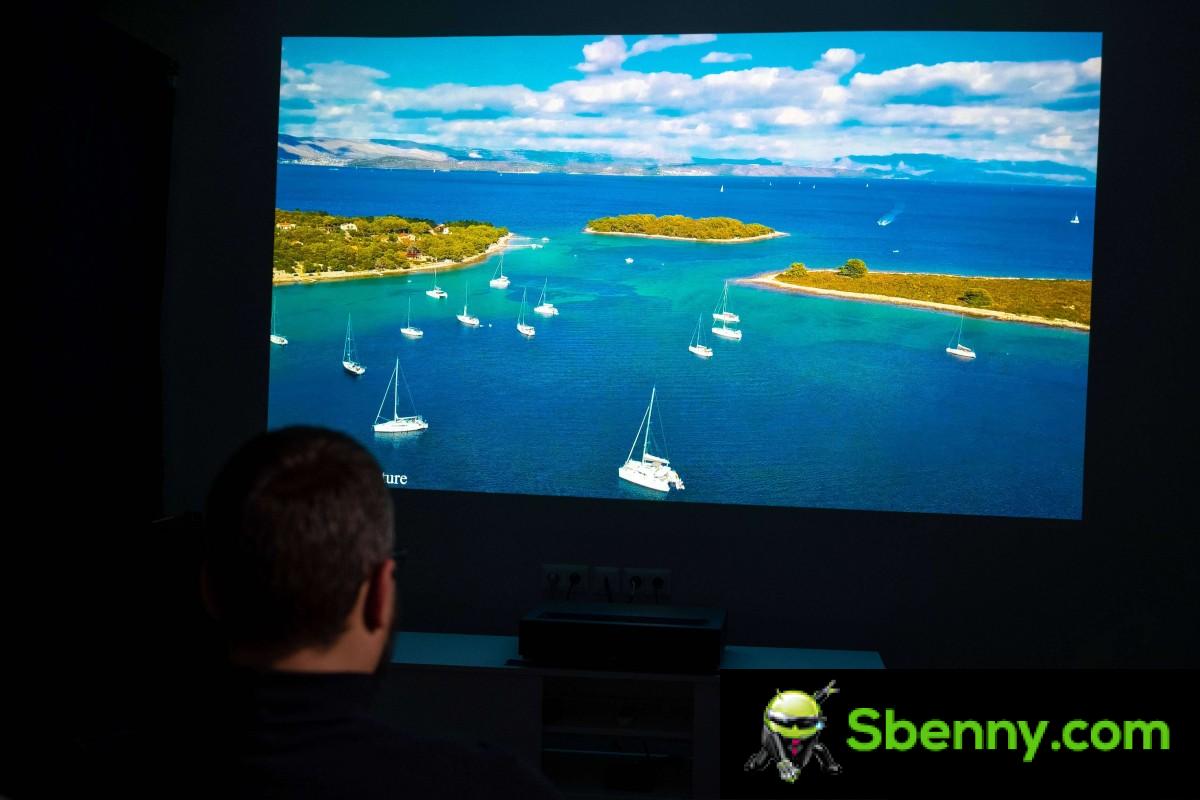
On kwalità tal-immaġini and starting from the brightness. The Formovie THEATER is bright enough to use in a dark room and really glows in complete darkness. It is usable only with very small screen diagonals during the day. If you invest in a projection screen, the perceived brightness would increase dramatically making it usable in brighter environments.
The advertised brightness figure of 2800 ANSI lumens seems about right as the Formovie THEATER can even become unpleasant to look at at night. We don’t have the proper equipment to test the exact brightness output, but it clearly has enough to throw around.
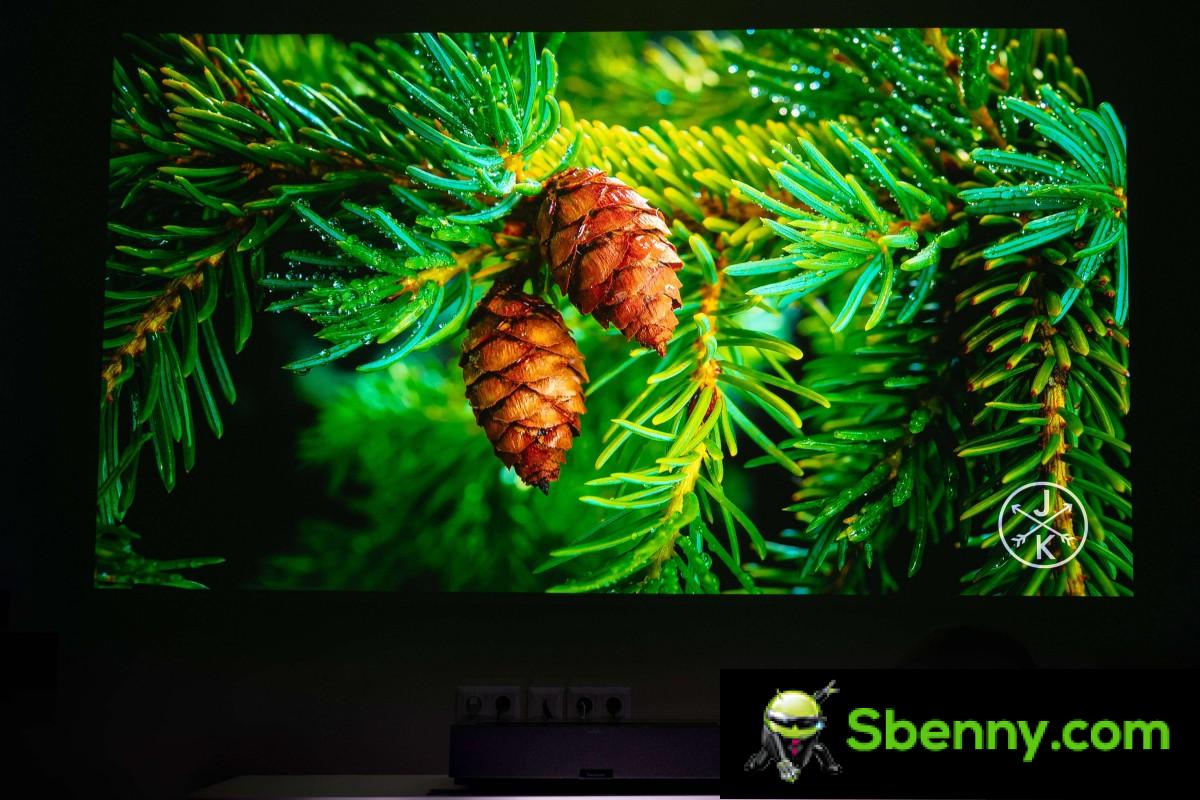
The Formovie THEATER has some brightness settings. There are three separate brightness modes. These are “Office Mode”, “View Mode” and “Night Mode” with decreasing brightness levels. As you’d expect, night mode generally gives you the best possible colors as these aren’t distorted to increase brightness and readability.
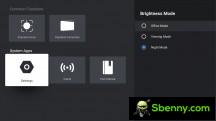
Mod ta 'luminożità
The Formovie THEATER has outstanding overall picture quality. The colors are vivid and the contrast is great. It can use a bit of fine-tuning, but it can impress even at its default settings. Black levels are among the best in class.
The native 4K resolution helps greatly with sharpness. Once heated to the correct operating temperature and focused correctly, THEATER is so sharp you can distinguish individual pixels. The HDR performance is a real highlight with excellent tone mapping and contrast.
The Formovie THEATER has a number of pre-set color profiles and thankfully there is also a custom profile which allows you to adjust individual parameters as you see fit.
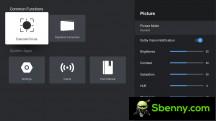


Color profiles and settings
The video options are really in-depth on the unit. These can be set based on display mode and input, so you can really dial things in any way you like. If you’re like us and want the purest picture experience possible with the least amount of post-processing and input latency, you’ll probably want to turn off most of these options. Especially things like noise reduction and MEMC.

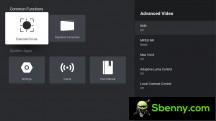
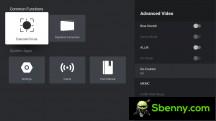

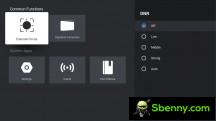
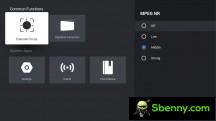

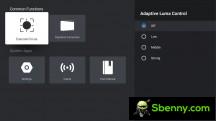





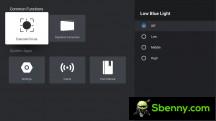
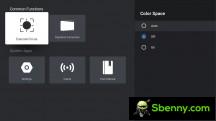


In-depth image settings
Formovie THEATER offers quite convenient focus and keystone correction menus. These are two separate interfaces, although they overlap somewhat in their functionality. The latter can make finer adjustments on an angle-by-angle basis. Easier keystone corrections are also available.



Focus and keystone adjustments
The Formovie THEATER can also be configured to project an upside down image or perform a rear projection if your setup requires it.

Projection method settings
Naturally, we tried connecting the Formovie THEATER to a few different devices. A 4K PC works really well as there is plenty of resolution to read fine text. This works best if you haven’t turned on chroma downsampling and probably want to enable YCbCr color mode on your PC. You can quickly change the picture settings for the HDMI port from a convenient context menu on the projector’s remote control, including items such as CEC support and display and color modes.
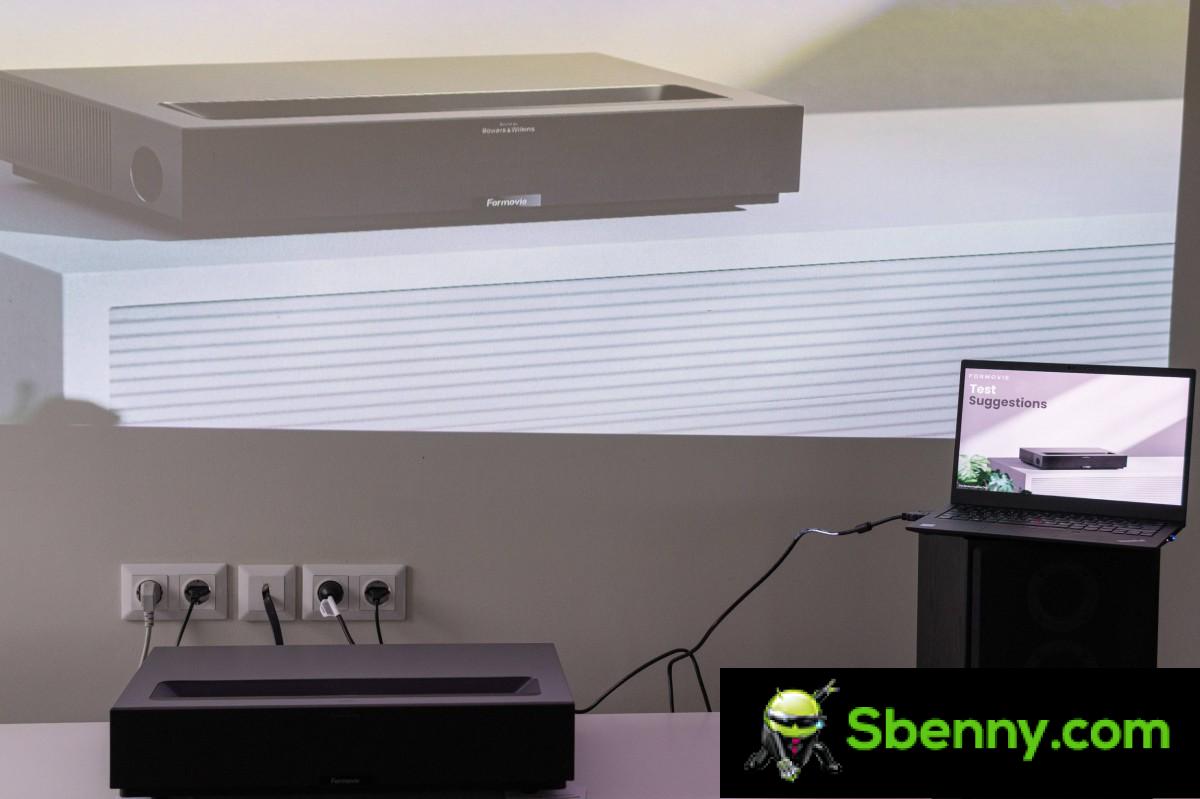
We also tried to play. The Formovie THEATER has a dedicated game mode and does well in reducing input latency to around 40ms which is good enough for casual gaming. We tried a PC, a Nintendo Switch and a Valve Steam Deck. Everything worked solid.
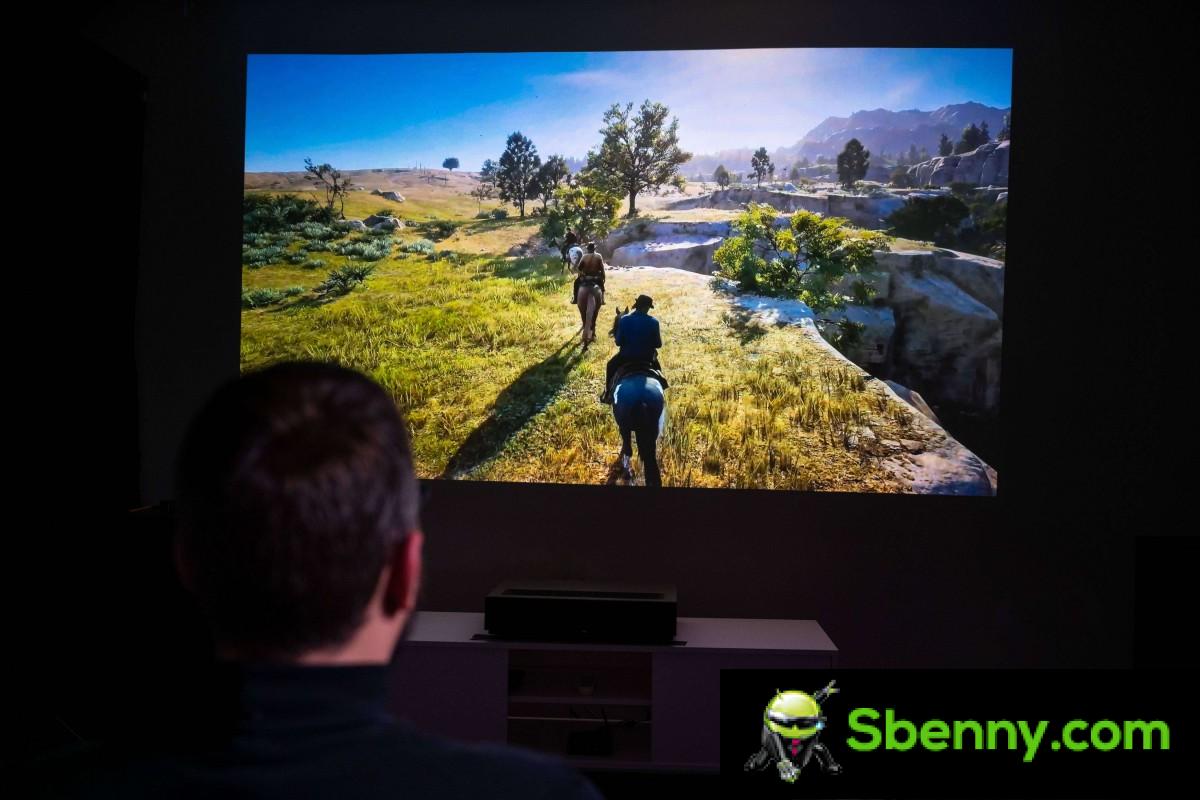
Optical resolution works a little differently than traditional monitors, and is generally more forgiving of low-resolution inputs. Dropping the resolution down to 1080p still produced a pretty sharp image relying solely on upscaling the projector itself. While we wouldn’t necessarily recommend a “THEATER” product for gaming, this does allow it to do double duty.
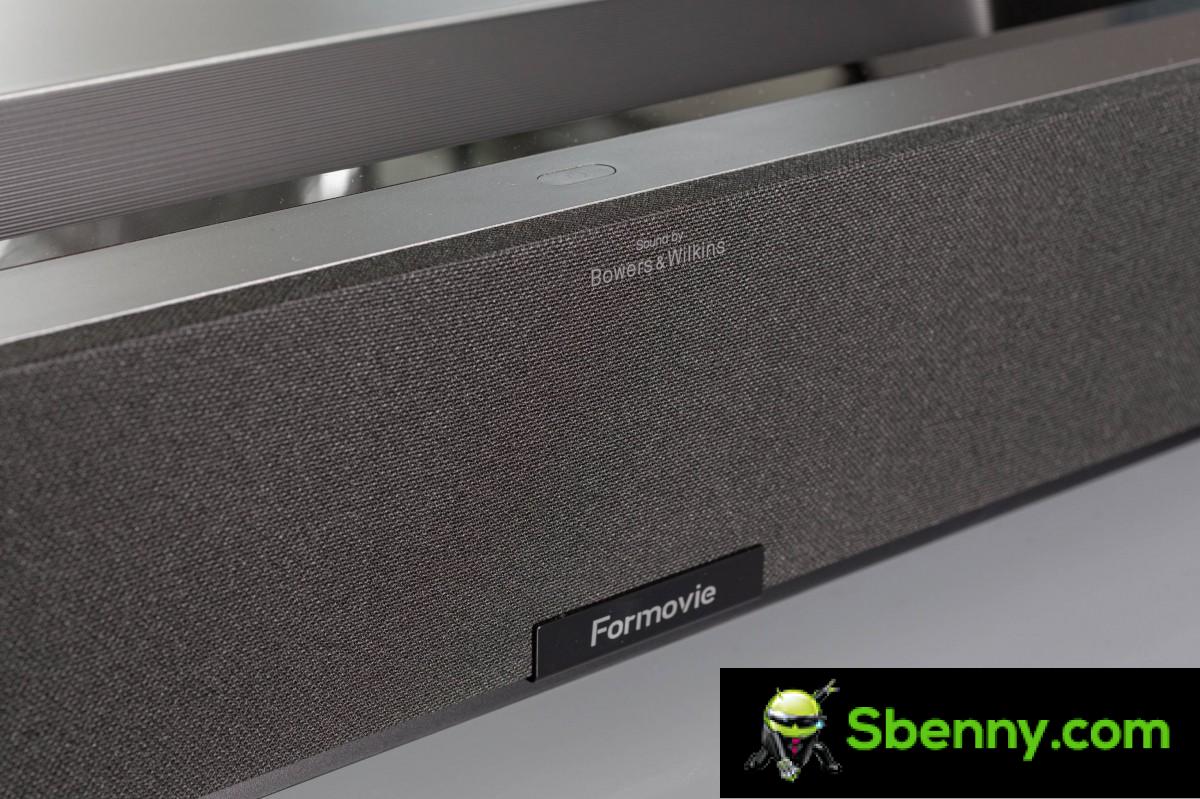
Audio output from the onboard speaker system is rich and full. Not surprising, given that Bowers and Wilkins tuned it. Mids such as vocals and dialogue come out very clean and audible. The highs are also crisp and not distorted in any noticeable way, even at high volumes. There’s a surprising amount of bass too. Nothing earth-shattering, of course, but more than enough for a casual movie experience.
Moving on to the audio settings, there are hardly any settings available for the video output. You can turn Dolby Audio on and off, as well as a volume leveler and audio virtualizer on your internal speaker setup.


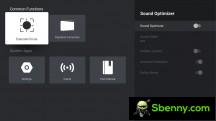

Settings tal-ħoss
There are also audio desync settings, but these are most likely useful with an external speaker setup. Formovie THEATER has a 3.5mm jack for basic stereo output, TOSLINK (S/PDIF) and eARC support on one of its HDMI ports. There is no shortage of audio output options.
Karatteristiċi Software
Unlike the Formovie/FENGMI R1 Nano we recently reviewed, the Formovie THEATER unit we received isn’t running a proprietary FengOS or anything like that. Instead, it has a clean install of Android TV version 11. It’s technically not the latest version of Google’s operating system, but Android TV 12 isn’t technically available yet, so you’re getting a fully-fledged current software experience.
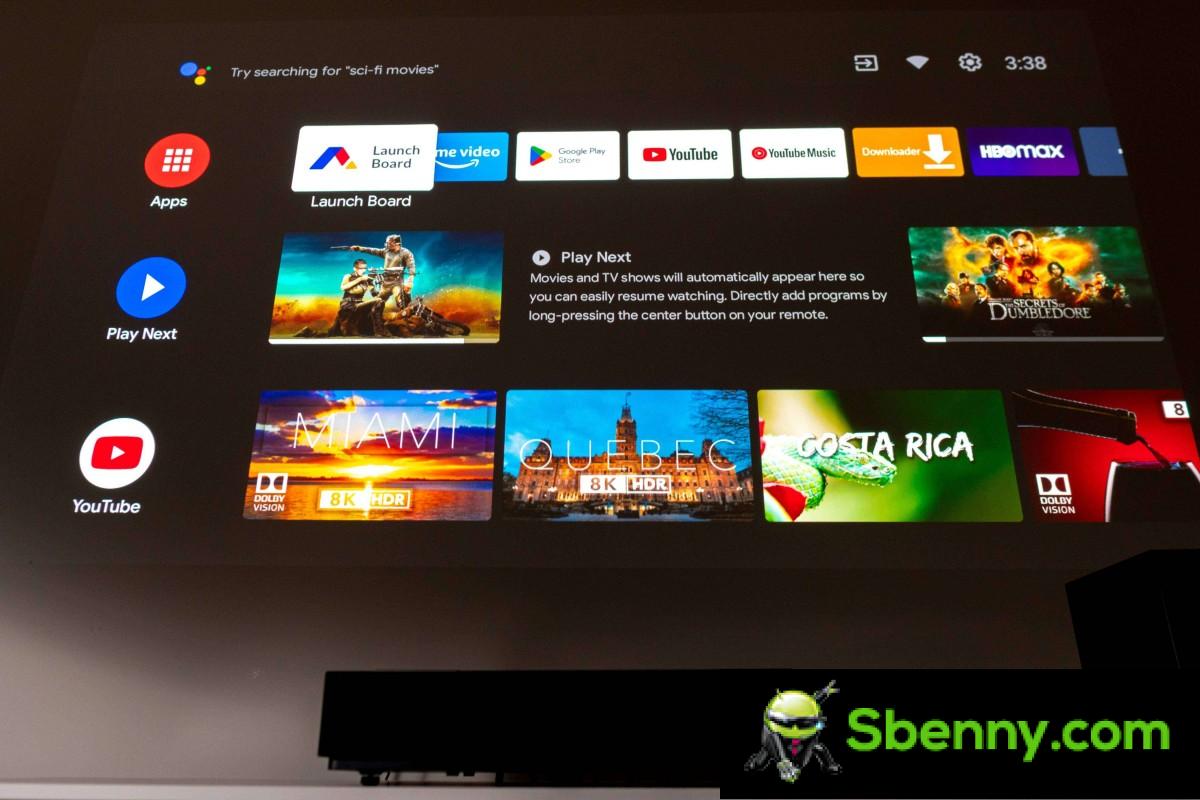
If you’ve seen Android TV before, you’ll feel right at home here. The main user interface is very clean and is based on a row interface that Google calls channels. There are some general ones, but also ones that surface content from third-party apps installed on your device. Beyond that is a simple app drawer, a simple notification interface, an input selector, and the settings we’ve already looked at in the previous section. Clean and direct.





Android TV user interface
There are far fewer built-in features and apps here than on FengOS, which is both good and bad. Some things are noticeably missing, like a proper file manager and default video player app. On the plus side, however, our Formovie THEATER unit has Servizzi ta 'Google Play, including the Google Play Store. The latter is a specific version for Android TV and with a limited selection of apps. However, you can find great options here to cover all the bases, like players, file managers, and the like.
Unless you intend to play all your content from a USB-attached storage device, the most important piece of information regarding the software experience at Formovie THEATER is how well it handles Servizzi ta 'streaming.
In no particular order, YouTube works great. The app came pre-installed on the projector and is more than happy to deliver 4K HDR content at 60fps. It even activates the appropriate HDR video mode on the projector, which is great to see.

youTube
Disney+ works perfectly after installing from Play Store. The same goes for HBO Max and Amazon Prime Video. However, we have no way of verifying the actual resolution of any of these streaming services on Formovie THEATRE.




Servizzi ta 'streaming
If you want to get your hands a little dirty and start your own movie collection, then our first suggestion would be Plex. Worked great on Formovie THEATER after downloading the app from play store. We were able to play some high bitrate 4K HDR content with HDR and surround sound working perfectly.


Plexus
Netflix is the one major and notable omission in the Formovie THEATRE. For whatever reason, the Android TV version from the Play Store refuses to work. Sideloading a regular Android APK works with broken UI navigation and accessing SD quality streams only.



Netflix has big problems
For this reason alone, we would probably suggest purchasing an external streaming stick or box with better software support for use with Formovie THEATRE. If you’re not into Netflix, however, installing it on your Android TV is actually very clean, usable, and incredibly snappy and responsive.
Video playback functionality and performance
Speaking of Netflix, its insistence on providing only SD streaming quality, while not unexpected, was a bit perplexing as Netflix claims that Formovie THEATER only has Widevine L3 DRM. In fact, it has the highest possible L1 certification, which should allow for HD and more streaming. The discrepancy likely stems from the lack of official Netflix support, so the app fails to recognize it properly.

Widevine L1
The Formovie THEATER has a MediaTek MT9629 chipset that powers its Android smart TVs with 2GB of RAM and 32GB of onboard storage. The chip has a total of four ARM Cortex-A55 CPU cores clocked at up to 1.5GHz and a Mali-G52 2EE MC1 GPU. You shouldn’t aim to play on the Formovie THEATRE. Just for fun, we ran some traditional benchmarks. It scored 364 points in the Geekbench multi-core test at 7 fps on screen on GFXBench Manhattan 3.0 and 615 points on 3DMark Sling Shot. If these figures mean nothing to you, they’re pitifully low.

The fact of the matter is that the MediaTek MT9629 isn’t actually a generic ARM chipset like you might find in a smartphone or tablet. MediaTek also markets it as an “intelligent display SoC”. Its real strength is media decoding and playback. The MediaTek MT9629 has an excellent hardware decoder, which supports AV1, AVS2, HEVC, VP9, H.264, SHVC 4K60@10bit for video decoding and BBC HLG, HDR10 (SMPTE2084), Dolby Vision HDR, Technicolor/Philips JHDR (ESTI TS 103 433 ), HDR10+ of HDR standards. Plus, Dolby Atmos and DTS Virtual X for audio. You can see a full list of supported codecs below.






Codecs appoġġjati
The Formovie THEATER basically chewed through every media test file we threw at it with ease and stutter-free. Even 4K content with an insanely high bitrate didn’t prove to be a challenge for the hardware decoder.
Ħsibijiet Finali
We had a wonderful time with Formovie THEATRE. It’s easily one of the best in its class of projectors and price point. Currently, it will take you back $3,500which is no small sum, but is very reasonable for the excellent all-round performance and feature set that THEATER offers.

Its unfortunate limitation of Neflix means that you either don’t have to worry about that particular streaming platform or be willing to jump through extra hoops to make it work. If you don’t fit into either of these groups then it’s best to look elsewhere, but members of both should have THEATHER 4K UST on their list.
It will offer an excellent all round experience in a light controlled room. Don’t forget to get a decent quality screen if you plan to use it even in daytime with ambient light around.







Ibda Thread ġdid